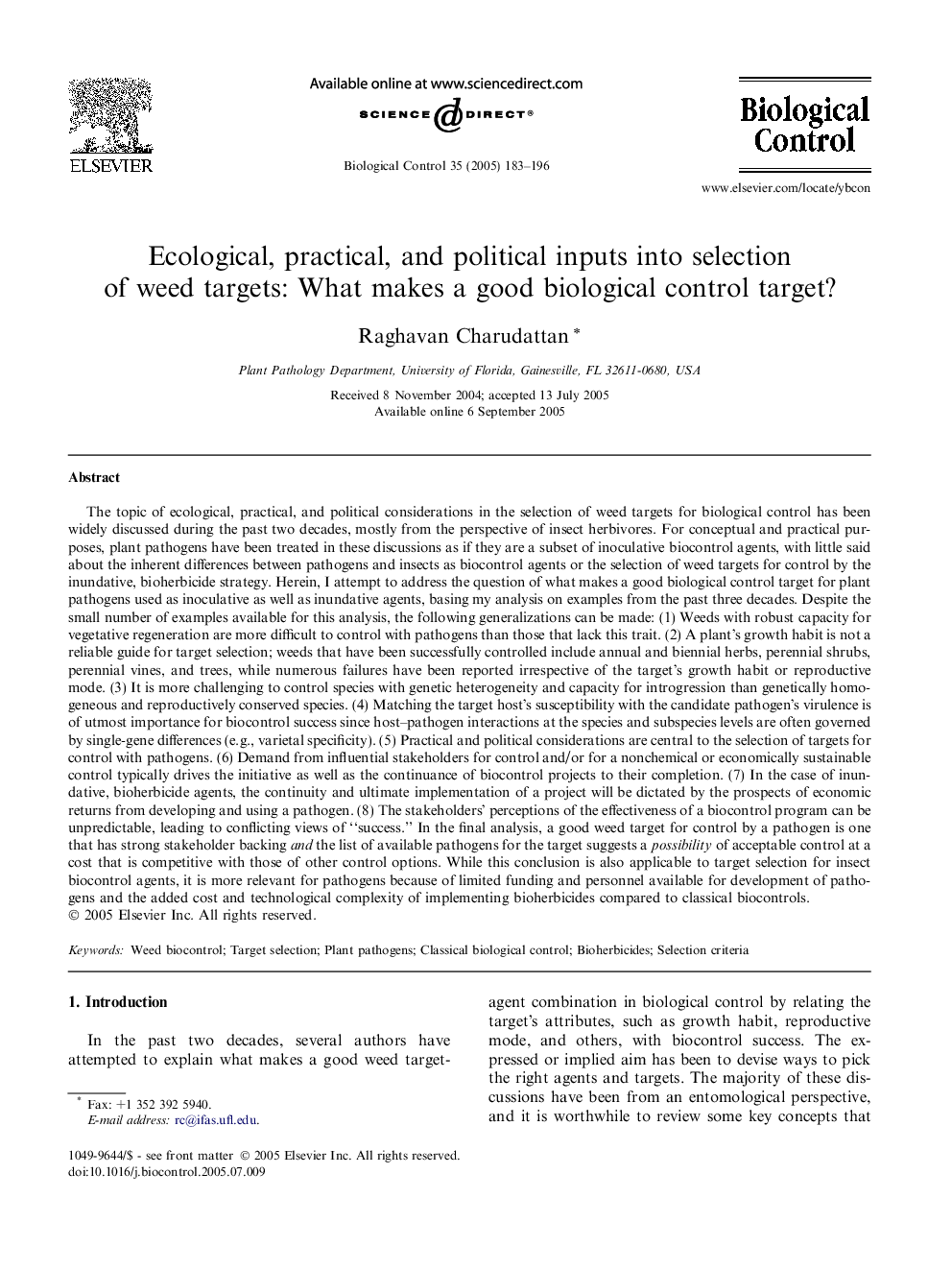| کد مقاله | کد نشریه | سال انتشار | مقاله انگلیسی | نسخه تمام متن |
|---|---|---|---|---|
| 9471887 | 1321141 | 2005 | 14 صفحه PDF | دانلود رایگان |
عنوان انگلیسی مقاله ISI
Ecological, practical, and political inputs into selection of weed targets: What makes a good biological control target?
دانلود مقاله + سفارش ترجمه
دانلود مقاله ISI انگلیسی
رایگان برای ایرانیان
کلمات کلیدی
موضوعات مرتبط
علوم زیستی و بیوفناوری
علوم کشاورزی و بیولوژیک
علوم زراعت و اصلاح نباتات
پیش نمایش صفحه اول مقاله

چکیده انگلیسی
The topic of ecological, practical, and political considerations in the selection of weed targets for biological control has been widely discussed during the past two decades, mostly from the perspective of insect herbivores. For conceptual and practical purposes, plant pathogens have been treated in these discussions as if they are a subset of inoculative biocontrol agents, with little said about the inherent differences between pathogens and insects as biocontrol agents or the selection of weed targets for control by the inundative, bioherbicide strategy. Herein, I attempt to address the question of what makes a good biological control target for plant pathogens used as inoculative as well as inundative agents, basing my analysis on examples from the past three decades. Despite the small number of examples available for this analysis, the following generalizations can be made: (1) Weeds with robust capacity for vegetative regeneration are more difficult to control with pathogens than those that lack this trait. (2) A plant's growth habit is not a reliable guide for target selection; weeds that have been successfully controlled include annual and biennial herbs, perennial shrubs, perennial vines, and trees, while numerous failures have been reported irrespective of the target's growth habit or reproductive mode. (3) It is more challenging to control species with genetic heterogeneity and capacity for introgression than genetically homogeneous and reproductively conserved species. (4) Matching the target host's susceptibility with the candidate pathogen's virulence is of utmost importance for biocontrol success since host-pathogen interactions at the species and subspecies levels are often governed by single-gene differences (e.g., varietal specificity). (5) Practical and political considerations are central to the selection of targets for control with pathogens. (6) Demand from influential stakeholders for control and/or for a nonchemical or economically sustainable control typically drives the initiative as well as the continuance of biocontrol projects to their completion. (7) In the case of inundative, bioherbicide agents, the continuity and ultimate implementation of a project will be dictated by the prospects of economic returns from developing and using a pathogen. (8) The stakeholders' perceptions of the effectiveness of a biocontrol program can be unpredictable, leading to conflicting views of “success.” In the final analysis, a good weed target for control by a pathogen is one that has strong stakeholder backing and the list of available pathogens for the target suggests a possibility of acceptable control at a cost that is competitive with those of other control options. While this conclusion is also applicable to target selection for insect biocontrol agents, it is more relevant for pathogens because of limited funding and personnel available for development of pathogens and the added cost and technological complexity of implementing bioherbicides compared to classical biocontrols.
ناشر
Database: Elsevier - ScienceDirect (ساینس دایرکت)
Journal: Biological Control - Volume 35, Issue 3, December 2005, Pages 183-196
Journal: Biological Control - Volume 35, Issue 3, December 2005, Pages 183-196
نویسندگان
Raghavan Charudattan,